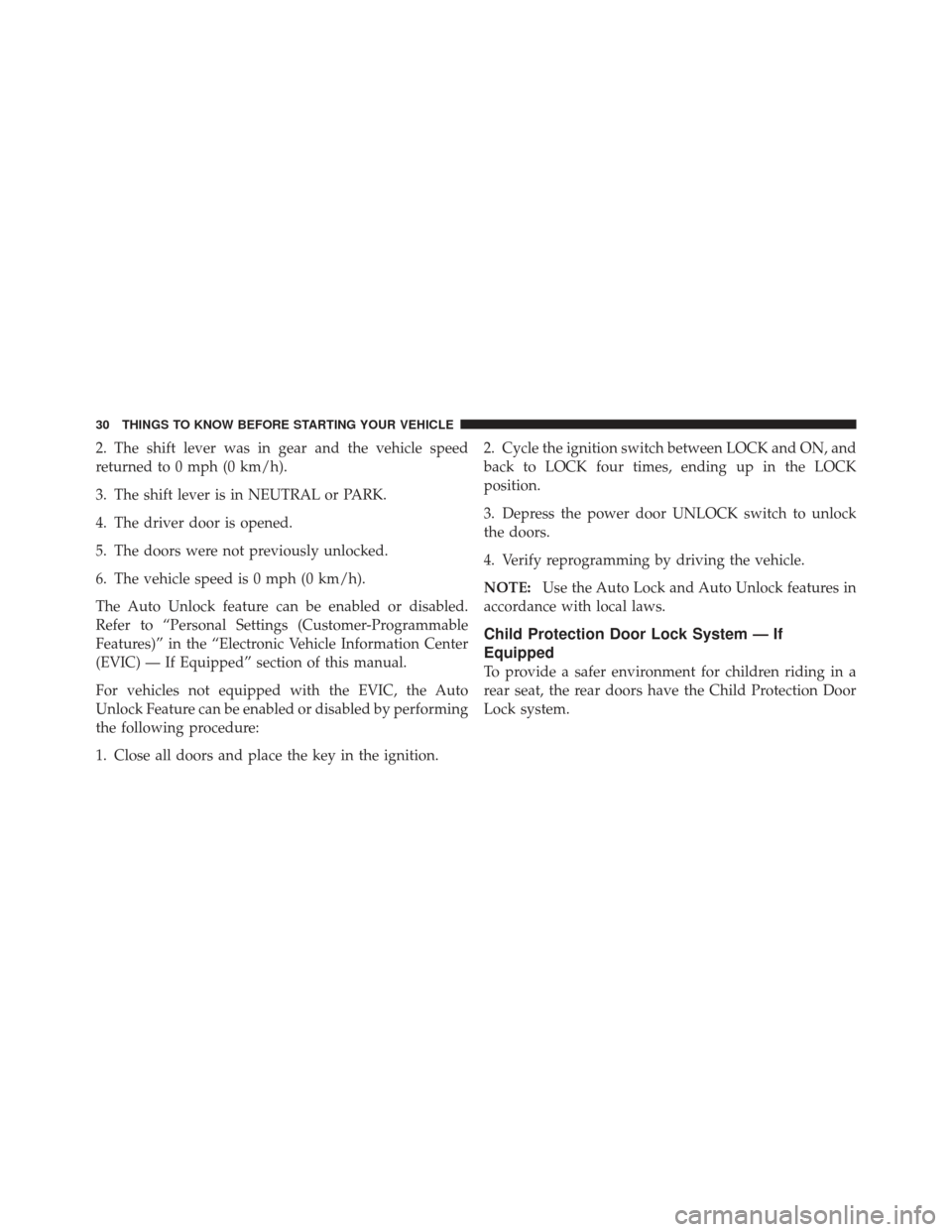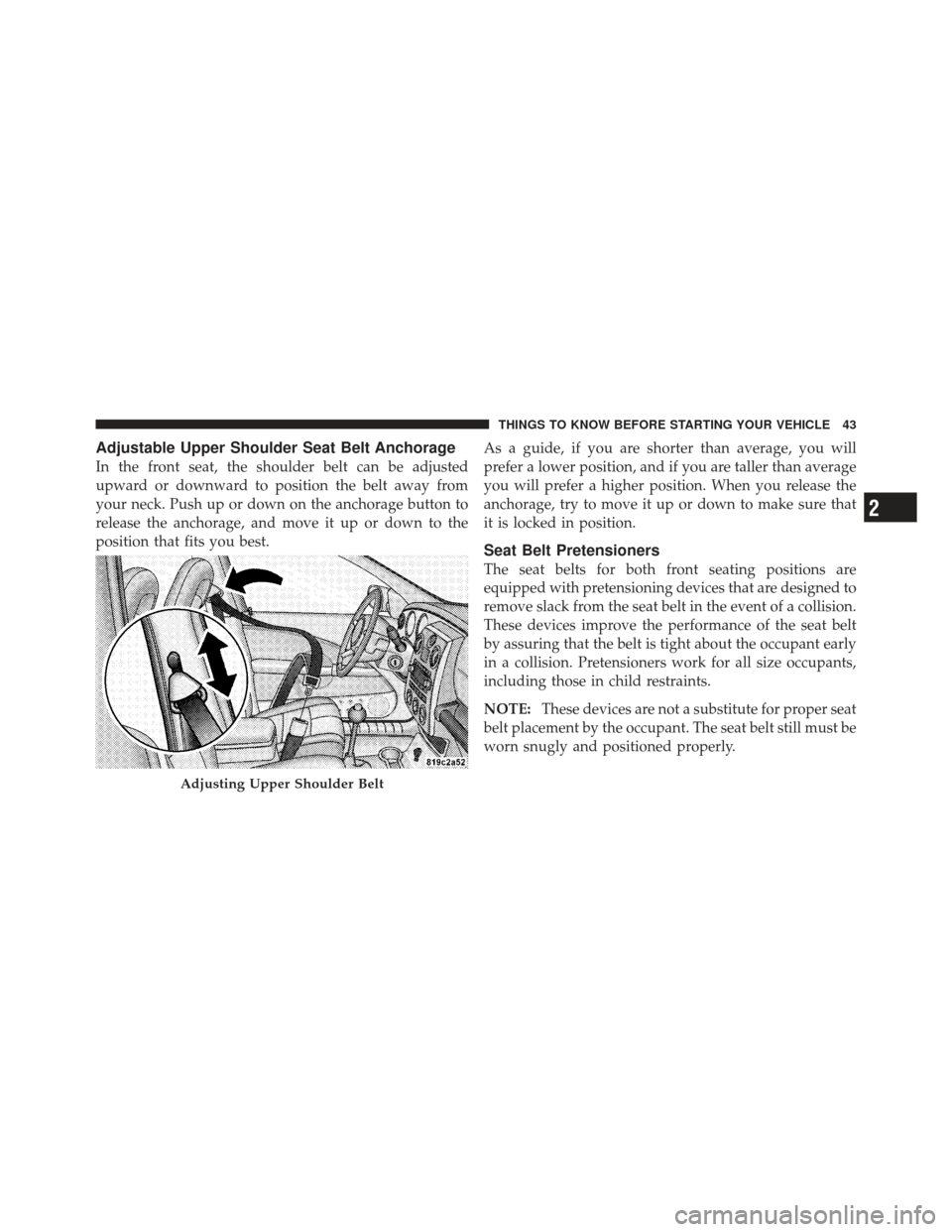Page 12 of 410

�Remote Keyless Entry (RKE) .............. 20
▫ To Unlock The Doors And Liftgate ......... 21
▫ To Lock The Doors And Liftgate .......... 22
▫ To Turn Off “Flash Lights With Lock” ....... 22
▫ Panic Alarm ......................... 23
▫ To Program Additional Transmitters ........ 23
▫ General Information ................... 25
▫ Transmitter Battery Service .............. 26
� Door Locks ........................... 27
▫ Manual Door Locks ................... 27
▫ Power Door Locks .................... 28
▫ Child Protection Door Lock System —
If Equipped ......................... 30 �
Power Windows ....................... 31
▫ Auto-Down Feature ................... 32
▫ Rear Window Switches ................. 33
▫ Wind Buffeting ....................... 33
� Liftgate ............................. 33
� Occupant Restraints ..................... 35
▫ Lap/Shoulder Belts .................... 36
▫ Lap/Shoulder Seat Belt Untwisting
Procedure ........................... 42
▫ Adjustable Upper Shoulder Seat Belt
Anchorage .......................... 43
▫ Seat Belt Pretensioners ................. 43
▫ Enhanced Seat Belt Use Reminder System
(BeltAlert�) ......................... 44
10 THINGS TO KNOW BEFORE STARTING YOUR VEHICLE
Page 15 of 410
NOTE:If you try to remove the key before you place the
shift lever in PARK, the key may become trapped tem-
porarily in the ignition cylinder. If this occurs, rotate the key to the right slightly, then remove the key as de-
scribed. If a malfunction occurs, the system will trap the
key in the ignition cylinder to warn you that this safety
feature is inoperable. The engine can be started and
stopped but the key cannot be removed until you obtain
service.
WARNING!
Never leave children alone in a vehicle. Leaving
unattended children in a vehicle is dangerous for a
number of reasons. A child or others could be seri-
ously or fatally injured. Don’t leave the key in the
ignition. A child could operate power windows,
other controls, or move the vehicle.
Ignition Switch Positions
1 — LOCK
3 — ON
2 — ACC (ACCESSORY) 4 — START
2
THINGS TO KNOW BEFORE STARTING YOUR VEHICLE 13
Page 30 of 410
WARNING!
•For personal security and safety in the event of an
accident, lock the vehicle doors while you drive,
when you park, and when leaving the vehicle.
•When leaving the vehicle, always remove the key
from the ignition lock, and lock your vehicle. Do
not leave children unattended in the vehicle, or
with access to an unlocked vehicle. Unsupervised
use of vehicle equipment may cause severe per-
sonal injuries and death.
CAUTION!
An unlocked vehicle is an invitation to thieves.
Always remove the key from the ignition and lock all
the doors when leaving the vehicle unattended.
Power Door Locks
A door lock switch is on each front door panel. Press
either switch to lock or unlock the doors.
Power Door Lock Switch
28 THINGS TO KNOW BEFORE STARTING YOUR VEHICLE
Page 32 of 410

2. The shift lever was in gear and the vehicle speed
returned to 0 mph (0 km/h).
3. The shift lever is in NEUTRAL or PARK.
4. The driver door is opened.
5. The doors were not previously unlocked.
6. The vehicle speed is 0 mph (0 km/h).
The Auto Unlock feature can be enabled or disabled.
Refer to “Personal Settings (Customer-Programmable
Features)” in the “Electronic Vehicle Information Center
(EVIC) — If Equipped” section of this manual.
For vehicles not equipped with the EVIC, the Auto
Unlock Feature can be enabled or disabled by performing
the following procedure:
1. Close all doors and place the key in the ignition.2. Cycle the ignition switch between LOCK and ON, and
back to LOCK four times, ending up in the LOCK
position.
3. Depress the power door UNLOCK switch to unlock
the doors.
4. Verify reprogramming by driving the vehicle.
NOTE:
Use the Auto Lock and Auto Unlock features in
accordance with local laws.
Child Protection Door Lock System — If
Equipped
To provide a safer environment for children riding in a
rear seat, the rear doors have the Child Protection Door
Lock system.
30 THINGS TO KNOW BEFORE STARTING YOUR VEHICLE
Page 33 of 410
To use the system, open each rear door and move the
control up to engage. When the system on a door is
engaged, that door can only be opened by using the
outside door handle even if the inside door lock is in the
unlocked position.WARNING!
Avoid trapping anyone in a vehicle in a collision.
Remember that the rear doors can only be opened
from the outside when the Child Door Protection
Lock is engaged.
NOTE: For emergency exit with the system engaged,
move the lock plunger up (UNLOCKED position), roll
down the window and open the door with the outside
door handle.
POWER WINDOWS
The power window switches are located on the instru-
ment panel above the radio. The top left switch controls
the left front window and the top right switch controls
the right front window.
The lower left switch controls the left rear window and
the lower right switch controls the right rear window.
Child Lock Control
2
THINGS TO KNOW BEFORE STARTING YOUR VEHICLE 31
Page 34 of 410
The window lock switch is located between the window
switches, that allows you to disable the rear window
switches that are located at the back of the center floor
console.WARNING!
Never leave children in a vehicle with the key in the
ignition switch. Occupants, particularly unattended
children, can become entrapped by the windows
while operating the power window switches. Such
entrapment may result in serious injury or death.
Auto-Down Feature
The driver’s and passenger’s front window switches
have an Auto-Down feature. Press the window switch
past the detent, release, and the window will go down
automatically. Press the switch a second time in either
direction to stop the window.
To open the window part way, press the window switch
part way and release it when you want the window to
stop.
Power Window Switches
32 THINGS TO KNOW BEFORE STARTING YOUR VEHICLE
Page 37 of 410

OCCUPANT RESTRAINTS
Some of the most important safety features in your
vehicle are the restraint systems. These include:
•Front and rear seat belts for all passengers
•Front airbags for both the driver and front passenger
•Pretensioning and load-limiting retractors for the front
seat belts
•Knee Impact Blocker panels for front seat occupants
•Supplemental Side Airbag Inflatable Curtains (SABIC)
that span the front and second rows for sedans (if
equipped)
•Front seat belt retractors that incorporate pretension-
ers to enhance occupant protection by managing oc-
cupant energy during an impact eventIf you will be carrying children too small for adult-sized
seat belts, the seat belts or the Lower Anchors and Tether
for CHildren (LATCH) feature can also be used to hold
infant and child restraint systems.
Refer to the Lower Anchors and Tether for CHildren
(LATCH) system explanation in this section.
Please pay close attention to the information in this
section. It tells you how to use your restraint system
properly, to keep you and your passengers as safe as
possible.
2
THINGS TO KNOW BEFORE STARTING YOUR VEHICLE 35
Page 45 of 410

Adjustable Upper Shoulder Seat Belt Anchorage
In the front seat, the shoulder belt can be adjusted
upward or downward to position the belt away from
your neck. Push up or down on the anchorage button to
release the anchorage, and move it up or down to the
position that fits you best.As a guide, if you are shorter than average, you will
prefer a lower position, and if you are taller than average
you will prefer a higher position. When you release the
anchorage, try to move it up or down to make sure that
it is locked in position.
Seat Belt Pretensioners
The seat belts for both front seating positions are
equipped with pretensioning devices that are designed to
remove slack from the seat belt in the event of a collision.
These devices improve the performance of the seat belt
by assuring that the belt is tight about the occupant early
in a collision. Pretensioners work for all size occupants,
including those in child restraints.
NOTE:
These devices are not a substitute for proper seat
belt placement by the occupant. The seat belt still must be
worn snugly and positioned properly.
Adjusting Upper Shoulder Belt
2
THINGS TO KNOW BEFORE STARTING YOUR VEHICLE 43